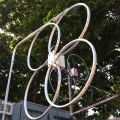PI Build
I had a Black anodised case, a PI 3B in a black anodised passive case, some scrap ali (to make temporary end plates for layout testing), some files and blunt drills, what could go wrong.
Fan is not connected and I've not worked out what to do with the front for access/air intake but fan-off it runs at the same temperature as the other PI with a small heatsink and case fan.
14CH wspr mode.




Gaffa is there as there are some cut ends on the ribbon and was doing alot of moving stuff around.
Once I work out the layout I'll work on the real end plates.
I'll probably combine the retainer plate with fixings for the Kiwi, right now it is sat (via nylon standoff) on the PI case.
Stu
Fan is not connected and I've not worked out what to do with the front for access/air intake but fan-off it runs at the same temperature as the other PI with a small heatsink and case fan.
14CH wspr mode.




Gaffa is there as there are some cut ends on the ribbon and was doing alot of moving stuff around.
Once I work out the layout I'll work on the real end plates.
I'll probably combine the retainer plate with fixings for the Kiwi, right now it is sat (via nylon standoff) on the PI case.
Stu

Comments
Whether you have improved performance vs a more floating/isolated antenna/ground or not should be verified, I think.
Swapped it over from the Beagelbone AI last night in a way that should not disrupt the Wsprdaemon graphs, my intention was to compare as an "obvious jump or fall" in the various bands.
I could hardly spot where the change took place, normal local noise differences were much larger than any change. (those plots are public so anyone can check - M0AQY from about 20:40UTC yesterday).
The AI was in the official case, non-grounded SMA, this is grounded, can't be that much difference if the noise plots are indistinguishable.
I do have another instance of OpenWebSDR running on it too, that does put USB noise on 80m if I run a USB SDR at the same time as Kiwi/WSPR.
Might just put 80m WSPR on another RX so I can save having to run another PI for above 30MHz.
Just need to work out how to pipe the other SDR data in the now excellent Kiwi audio.
There are lots of general QRM generators close by but most have a signature like roughly hour run, - "10bd 30m" (I'm not sure what that one is next door for sure). New PC to test probably.